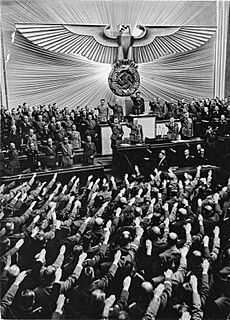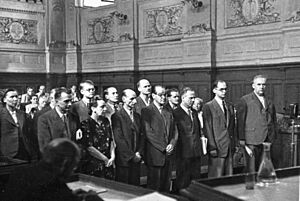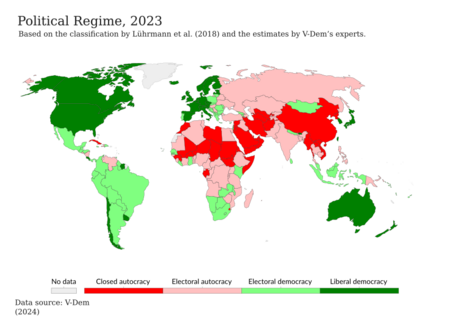Autocracy facts for kids
Autocracy is a type of government where one person or a small group holds all the power. This person is called an autocrat. Think of it like a king or queen with total control (some monarchies are like this) or a dictatorship. This is different from a democracy, where people vote for their leaders.
In an autocracy, the ruler decides everything, including people's freedoms, like what they can say or do. Sometimes, a country might mix autocracy with democracy. These are called hybrid regimes or electoral autocracies. People have known about autocracy since ancient times.
How do autocrats stay in power? They often stop anyone who disagrees with them and try to get important people on their side. They might use propaganda (information, often biased, used to promote a political cause) to control what people think. Autocrats might say they have the right to rule because of their family (birthright), religion, or because they are protecting the country from enemies. Some autocracies even have pretend elections or courts to look like a democracy, but the autocrat is still in charge.
Autocrats need to keep powerful people and groups in the country under their control. But they also have to make sure no one else gets too powerful and tries to take over, perhaps through a coup d'état (a sudden, often violent, takeover of government).
Autocracy is one of the oldest ways to govern. It started with powerful chiefs leading tribes, and then kings ruling city-states and empires. For a long time, monarchy was the main type of autocracy. Dictatorships became more common in the 1800s. In the 1900s, some dictatorships became totalitarian, meaning they tried to control every part of people's lives.
Contents
- Where Does the Word "Autocracy" Come From?
- How is an Autocracy Structured?
- How Do Autocracies Start and Stay in Power?
- What Are the Different Kinds of Autocracy?
- A Look Back at Autocracy Through Time
- How Autocrats Rule Day-to-Day
- How Experts Study and View Autocracy
- Related pages
- Images for kids
- See also
Where Does the Word "Autocracy" Come From?
The word autocracy comes from two Ancient Greek words:
- auto (Greek: αὐτός), which means "self"
- kratos (Greek: κράτος), which means "power" or "might"
So, "autocracy" basically means "self-power" or power held by one person. The Greek word autocrator (Greek: αὐτοκράτωρ) was a title for the Roman emperor. The Russian emperors also had a similar title. Later, people started using "autocrat" to describe any ruler with total power. Today, the word "autocracy" often has a negative meaning, suggesting a harsh or unfair government.
How is an Autocracy Structured?
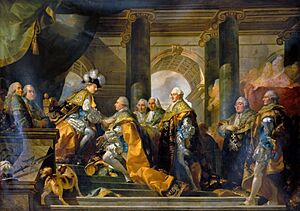
It's tricky to give one single definition for how an autocracy is set up. Usually, it means one ruler, the autocrat, has no limits on their power. But sometimes, a small group can rule this way too. What makes autocracy different is that the ruler can take away people's civil liberties (basic rights and freedoms) or decide which ones they get. It's not like a democracy or feudalism (a system in medieval Europe where lords owned land and knights served them). Today, people often call any government that isn't a democracy an autocracy.
Sometimes, autocracy can even happen in a small part of a country, like a town or region, if the main government doesn't have much control there.
Who Holds the Power?
In an autocracy, there are very few, if any, limits on the autocrat's power. Even if there are official groups or rules, they don't usually make the autocrat answer for their actions. To stay in charge, an autocrat needs help from powerful people (elites) in the country. These elites help the autocrat carry out their plans.
The amount of direct control an autocrat has can change. As their rule gets stronger, they build up organizations to help them rule. These organizations are needed to keep control and get resources from the country. But sometimes, these same organizations can also limit the autocrat's power a little.
Autocrats also have to be careful with regional leaders. If local leaders have too little power, it's hard to rule effectively. But if they have too much, they might start caring more about their region than about the autocrat.
Pretend Democracy?
Some autocracies have a legislature (a group of people who make laws), but it usually can't really challenge the autocrat. The elections for this legislature are often not free and fair. These groups can also be corrupt, with the autocrat giving special favors to members who support them. Other things, like fair courts or active community groups, can also sometimes limit an autocrat's power.
Ruling Families
Sometimes, an autocracy is more about a ruling family than just one person. This was common in many monarchies. Families could even marry into other ruling families, joining their kingdoms. Some dictatorships also focus on the ruler's family, like the Kim family in North Korea, where there's a strong cult of personality (when a leader is presented as an amazing, almost god-like figure).
How Do Autocracies Start and Stay in Power?
How Autocracies Form
The very first autocracies, like chiefdoms (groups of villages ruled by a chief), appeared in places where there wasn't a central government before. People think autocracies started because they seemed more organized than anarchy (no government at all). They could offer safety and stop fights within the group.
Some thinkers say autocrats are like "stationary bandits." Imagine bandits who decide to stay in one place instead of roaming around. These "stationary bandits" realize it's better to protect the people they rule and tax them, rather than just taking everything and leaving. This way, both the ruler and the people might be better off than if there were no rules at all.
Other experts believe early states weren't just one ruler, but a group of powerful people who agreed to work together. They shared power and resources to avoid fighting among themselves.
It's hard to predict which countries will become autocracies. The country's size, army strength, wealth, or culture don't seem to be the main reasons. However, autocracies might be more likely in places with very diverse populations, where there's more inequality and people don't feel as connected.
Staying in Power and Choosing the Next Ruler

Autocrats face many challenges. People might protest, other political groups might oppose them, or even their own supporters might turn against them. Since autocrats need the help of powerful elites, these elites are often the biggest threat. Most of the time, when an autocratic government is overthrown, it's by a coup d'état (a sudden takeover). Historically, another autocracy usually followed, though in Europe in the 1900s, more countries started moving towards democracy.
While people rising up is important to overthrow an autocrat, it usually also needs support from some elites who no longer want to back the ruler. It's very rare for an autocrat to be overthrown just by a popular revolt without any help from inside the government. When people in a country want democracy, it's a big challenge for an autocrat.
When a country gets richer and more modern, people often want more democracy. But if an autocrat fails to make the country better, they can also lose support. Revolts are most likely when the government is trying to make changes. If these changes don't meet people's hopes, or if they make the government weaker, people might rise up. If a revolt seems likely, an autocrat might give people more rights, share wealth, or even step down to avoid violence.
How is the Next Autocrat Chosen?
Some autocracies use hereditary succession, meaning there are rules (like in a royal family) about who becomes the next ruler. In other cases, the autocrat might pick their successor, or another group in the government might choose. This can be tricky because a chosen successor might try to take power early. This is less of a risk with hereditary successors, who are often younger and have less power.
If there's no plan for who takes over, there can be a big power struggle when the autocrat dies or is removed. This difference in choosing leaders is one way monarchies (which usually have set rules for succession) are different from dictatorships (which often don't). The time when one autocrat is replaced by another is very unstable. Having clear rules for succession can make the change smoother, but it doesn't guarantee the new leader will be good at their job.
Making People Believe the Ruler is Legitimate
Autocrats try to make people believe they have the right to rule. This is called legitimacy. They might say their rule is legal, or they might just use force. People, even within the country, can have different opinions on whether an autocratic government is legitimate.
If other countries accept an autocratic government, it can help convince its own people that it's legitimate. If other countries don't accept it, the autocrat might try to rally support by blaming foreign countries for their problems.
Historically, the most common reason given for the right to rule was birthright – being born into a ruling family.
- Religion: Some governments, called theocracies, say their right to rule comes from God, and religious leaders should also be political leaders. Many absolute monarchs also claimed to rule by "divine right," like kings in England and France in the 1600s, or the "Mandate of Heaven" for emperors in ancient China.
- Ideology: If an autocracy has a strong set of beliefs (an ideology), it might use this to justify its rule. This is common in communist or ethnonationalist (focused on one ethnic group) governments.
- Fake Elections: Autocracies with unfair elections might use the results to "prove" that the people want the autocrat to rule.
- Practical Reasons: Some autocrats argue they are needed to provide basic things for the people, like safety or food.
What Are the Different Kinds of Autocracy?
Autocracy includes most types of government that aren't democracies. This means dictatorships, many monarchies (rule by a king or queen), and places where one political party always stays in power. Monarchies were common in Europe long ago, but today, dictatorships are more common around the world.
Totalitarian vs. Authoritarian
Autocratic governments can be grouped into two main types:
- Totalitarian: These governments try to control almost every part of people's lives. They don't allow different political ideas or cultures. Everyone is expected to follow one main idea and show their support for the government. Totalitarian governments often want to completely change society and may use fear and violence against those who don't agree. Examples include communist states and Nazi Germany.
- Authoritarian: These governments control the country by stopping opposition, but they don't try to control every single aspect of life like totalitarian ones do. They don't usually force everyone to follow a strict state idea. Most traditional monarchies, military dictatorships, theocracies (rule by religious leaders), and states ruled by one party fall into this category.
Other Names for Autocratic Rule
- Despotism: This is when an autocrat rules completely by themselves, without any real organizations or rules helping them. This was more common before modern times when governments didn't have big, complex systems.
- Sultanism: This is a type of dictatorship where the ruler and their family are deeply involved in running the country, often through a cult of personality (making the leader seem almost like a god). They stay in power by rewarding friends and using force against enemies. There's often no clear guiding idea or fair legal system, and the state might just be used to make the leader rich.
Words like tyranny (cruel and unfair rule) and absolutism (where a ruler has total power) are also used to describe types of autocracy.
Mixing Autocracy and Democracy
Even though autocracies often limit people's rights, some might allow a few freedoms. These are sometimes called "closed autocracies" (no rights) versus others that allow some limited rights or even some political opposition.
There are also governments that mix parts of democracy and autocracy. These have many names, like:
- Anocracy
- Electoral autocracy (where there are elections, but they aren't really fair or free)
- Hybrid regimes (mixed systems)
Sometimes, a country might start as a democracy, but then an elected leader takes more and more control, turning it into an autocracy. Other times, an autocracy might slowly become more democratic.
A Look Back at Autocracy Through Time
For most of human history, autocracy was the main way countries were ruled.
How Autocracy Began in Ancient Times

One of the first types of government was the chiefdom. This is where a tribal chief ruled over a group of villages. This started way back in the Neolithic period (the late Stone Age). At first, chiefs might not have had total control, but over time, they often became more autocratic.
Early states were often formed by powerful military leaders (warlords) who conquered lands. The very first states were city-states in Mesopotamia (an ancient region in the Middle East) around 3500 BCE. Kings who were both political and religious leaders ruled these city-states. Later, Sargon of Akkad conquered these cities and created the first empire, the Akkadian Empire, in the 24th century BCE. Some Akkadian kings were even seen as gods. Ancient Egypt was also an autocracy for much of its early history.
China has been ruled by autocrats for almost its entire history since the Qin dynasty took over in 221 BCE. The ancient Chinese idea of Confucianism said that a good, strong ruler was important for order, and this idea shaped Chinese government for centuries.
In Ancient Greece, city-states were often ruled by "tyrants." The Roman Republic had a special role called a Roman dictator. This person would get total power for a short time to solve a crisis. But Julius Caesar changed this when he became "dictator for life" in 44 BCE. This marked the end of the Roman Republic and the start of the autocratic Roman Empire.
In East Asia, there were early military dictatorships, like in the Goguryeo kingdom in Korea (around 642 CE) and the shogunate (military government) in Japan from the 1100s to the 1800s.
Around the 1200s, kings in Europe started having larger groups of advisors, which was an early step towards parliaments. By the 1300s, strong monarchies became the main form of government in Europe, replacing the older feudal system.
Autocracy in More Recent Times
Starting in the 1500s, absolute monarchy (where the king or queen has total power) became more common in Europe. Rulers often said they had the "divine right of kings," meaning God chose them to rule. This was especially true in England and France.
The French Revolution (1789-1799) changed how people saw dictators. Revolutionaries said they were fighting against unfair rulers. In the 1800s, European monarchies started to lose some power as parliaments became stronger. In Latin America, powerful regional leaders called caudillos took control in some countries, becoming early dictators.
The 1800s and 1900s saw many old monarchies disappear, replaced by modern countries. Many of these new countries also became autocracies. After World War I (1914-1918), many European countries got rid of their monarchies or greatly reduced the monarch's power. Some became republics (countries without a king or queen).
During the time between World War I and World War II (the interwar period), totalitarian autocracies emerged. These took power in many countries, especially during the Great Depression (a worldwide economic crisis in the 1930s). This led to fascist, communist, and military dictatorships in Europe.
The Rise of Communist States
After the Russian Revolution in 1917, the first communist state was formed. This new type of autocracy had total control over its people, usually through a single powerful political party. While other dictatorships in Europe ended after World War II (1939-1945), communism became stronger and spread to many countries in Eastern Europe (the Eastern Bloc). For much of the late 1900s, communist states were a major model for autocracy.
Autocracy Around the World
As Western European countries became less autocratic, this affected other parts of the world through colonization (when one country takes control of another). Many colonized places later adopted democracy when they became independent. However, regions that already had strong autocratic traditions often kept them.
Autocracy became less powerful globally after the Cold War ended and the Soviet Union broke up in 1991. After many totalitarian regimes fell, authoritarian rule (less extreme than totalitarianism) became the main type of autocracy in the 21st century.
How Autocrats Rule Day-to-Day
Autocrats use several methods to stay in power and stop people from challenging them.
Keeping Control
One main way is through political repression. This means stopping anyone who might oppose them. This can be done quietly, by scaring or threatening people, or it can involve direct force.
Autocrats also use co-optation. This is when they give special benefits or positions to important and influential people in exchange for their support. It's often easier for an autocrat to win over these powerful people (elites) with rewards than to scare them with threats.
Having a single, powerful political party is a common tool for autocrats. The party helps control government members, bring in new supporters, and can make it harder for the military to try and take over. Autocracies ruled by a strong party tend to last longer.
Influencing the Public
To control what ordinary people think, autocrats use indoctrination (teaching people to accept a set of beliefs without questioning) and propaganda (spreading information, often biased, to support their rule). Surprisingly, people in autocracies can support their government just as much as people in democracies do. Being an autocracy doesn't automatically mean people dislike their rulers. Autocrats often try to gain popularity by supporting a particular political idea, ethnic group, or religion.
Autocracies and Other Countries
Different types of autocracies act differently towards other countries. In general, autocratic governments are more likely to go to war than democratic ones. This is partly because autocrats don't have to answer to all their citizens in the same way democratic leaders do. Totalitarian autocracies, especially fascist ones in the past, have often been very militaristic and tried to conquer other lands after they became powerful. This helps them spread their ideas and having foreign enemies can unite people at home behind the autocrat.
Modern Autocracies: Looking Democratic?
In the 21st century, many autocracies try to look more like democracies. They might allow some limited freedoms, like letting opposition parties exist and take part in unfair elections. These elections can help autocrats by:
- Giving a way to control or calm down the opposition.
- Providing a way to change leaders without fighting.
Many autocrats also use show trials (trials where the verdict is already decided) to deal with opponents, instead of just getting rid of them secretly. This can be a public warning to others not to cause trouble. In the past, elections in autocracies were often just for the elites to pick a leader from among themselves, like in an electoral monarchy (where a monarch is elected).
Creating a constitution (a set of basic laws for a country) is another thing autocrats do to stay in power. Since they can write the constitution themselves, they can make sure it suits their way of ruling.
How Experts Study and View Autocracy
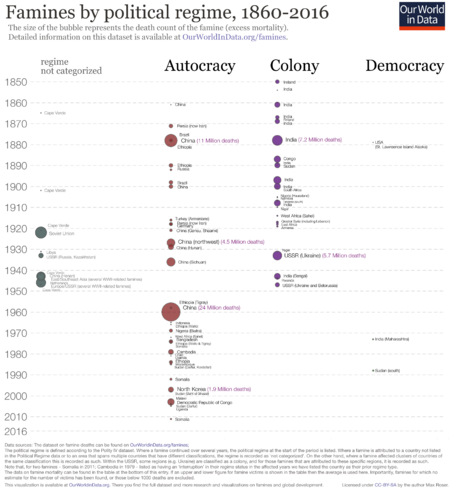
People have been thinking and writing about autocratic government since the time of Ancient Greek philosophers. Even though autocracy has been around for so long, it hasn't been studied as much as democracy. Most people think autocratic government is not as good as democratic government. This is because autocracies often have more corruption and violence. They also tend to be less efficient and not very good at protecting people's freedoms or being open about what they are doing.
Challenges in Studying Autocracy
In the past, it was hard to get good information about how autocratic governments worked. This made them difficult to study in detail. For example, it was especially hard to study autocracies in Africa after they became independent from colonial rule, because these governments often didn't keep good records, or they destroyed them. It has also been hard to study how much support citizens give to autocratic governments compared to democratic ones. Most studies on this have focused on East Asia. Luckily, in the 21st century, it has become easier to get information about autocracies, so experts can study them more closely.
Lasting Effects of Autocracy
Even after an autocratic government ends and a country becomes more democratic, the effects of autocracy can last for a long time. The way the government is structured and how it works can be affected. Studies have found that people's attitudes, what they want from their government, and how much they participate in politics can be different depending on whether their region was once under autocratic rule. This can even be true for different regions within the same country.
For example, people in countries that used to be communist (postcommunist nations) are often more likely to distrust the government and free markets. This can affect the country's economy for a long time. Also, dislike or fear of foreigners (xenophobia) is generally more common in countries that used to be autocracies. Voters in these places might be more likely to support political parties with extreme views.
Measuring Autocracy
Experts have created many "democracy indices" to measure how democratic or autocratic a country is. Some well-known ones are the Polity data series, the Freedom in the World report, and the Varieties of Democracy (V-Dem) indices. These tools look at different things, like:
- Who can vote (enfranchisement)
- Freedom of expression (can people speak freely?)
- Freedom of information (can people get information easily?)
- Separation of powers (are different parts of government separate and balanced?)
- Whether elections are free and fair
Different indices might look at slightly different things or measure them in different ways. But usually, they give similar results about which countries are democracies and which are autocracies. They mostly disagree on how to classify governments that mix democratic and autocratic features. These mixed systems are called by various names like hybrid regimes, anocracies, or electoral autocracies.
Changing Ideas About Autocracy
In the 1900s, Juan Linz, a political scientist, helped create the modern way of categorizing autocracies by dividing governments into democracy, authoritarianism, and totalitarianism. Later, in 1974, Gordon Tullock developed one of a theory specifically about autocraPcy.
After the Cold War ended around 1991, some experts thought autocracy would slowly disappear and be replaced by liberal democracy (democracy that protects individual rights). This idea was called the "end of history" by Francis Fukuyama. However, autocracy didn't disappear, and this theory became less popular. More recently, some people talked about "autocracy promotion," suggesting that some autocratic countries were trying to help other countries become autocratic too. But studies haven't found much proof that these efforts are very common or successful.
Related pages
- De facto rule, government
- Absolute monarchy
- Byzantine Empire
- Theocracy
- Totalitarianism
- Centralisation
- Kleptocracy
- Monocracy
- Oligarchy
- Statism
- Triumvirate
Images for kids
-
Nicholas II of Russia on the cover of Puck magazine, 1905 February 8.
-
Nicholas II of Russia was the last leader officially called an "autocrat" as part of his titles.
See also
 In Spanish: Autocracia para niños
In Spanish: Autocracia para niños


